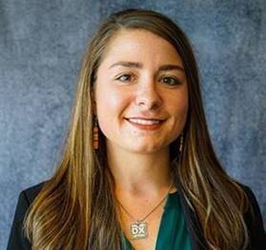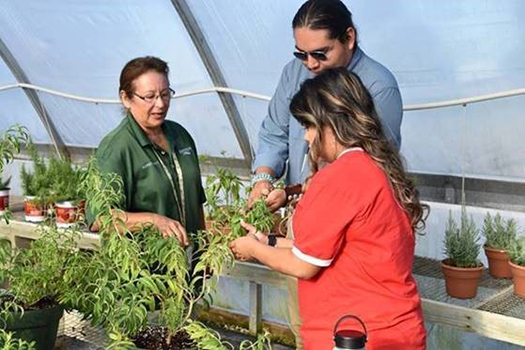November 9, 2021
In 1990, then President George H. W. Bush declared the month of November as National American Indian Heritage Month, commonly referred to today as Native American Heritage Month. For more than 30 years Americans have taken this time to celebrate the rich histories and contributions of Native people. It’s a great time to learn about the many tribes and raise awareness of unique challenges Native Americans have faced in the past and in the present.
Throughout the Department there is a greater emphasis than ever to ensure our programs are accessible to all and meet the needs of historically underserved communities. Our Risk Management Education projects are one important tool we have to educate and inform those producers who have lacked access to resources and training in the past.
Over the years we have worked well with the University of Arkansas Indigenous Food and Agriculture Initiative (IFAI) and the Intertribal Agriculture Council (IAC) to deliver risk management training to young Native producers. The largest education project we are funding this year is led by these two organizations.
Their project aims to develop and deliver educational information about risk management and crop insurance in a manner that is respectful and appropriate for Native producers. Additionally, they are providing training and technical assistance through their nationwide networks.
I recently had the pleasure of talking to the IAC’s Director of Programs, Kelsey Scott of the Lakota Tribe, about the work they are doing with their RMA funded national project this year. Kelsey is a self-described family-focused individual, which she says includes her four-legged family of horses, cattle, and dogs. Her family operates a direct-to-consumer grass fed beef operation on the Cheyenne River Sioux Indian Reservation. She also calls herself a soil and plant “nerd,” and an avid youth advocate. It seems the IAC is fortunate to have her as their Director of Programs.
Richard: We’re happy that we were able to provide funding for the important projects that you and others around the country are doing to educate producers on risk management. It seems to be an important and much discussed topic among Native farmers and ranchers.
Kelsey: When we found out about the funding, my initial thought was, “finally!” We, like our producers, feel even more empowered and capable of making a difference. Indian producers have historically been exposed to some of the greatest risks, with minimal access to protection. In most instances, this is no fault of their own, but merely a misunderstanding of how to extend risk management programming to Native producers functioning on Trust land. The IAC has been a stalwart voice throughout this era of underservice, helping the Risk Management Agency to best understand how to better extend resources and support to our Native producers. Now, through this project, we feel that our producers will become even more empowered and protected as we help to strengthen their relationship with RMA.

Kelsey Scott, Director of Programs,
Intertribal Agriculture Council (IAC)
Richard: What aspects of the training and information that IAC provides are critical to your students?
Kelsey: First, knowing how to identify the risks that are associated with one’s production. This is a critical component of needing to know how, why, and where they are most vulnerable. Second, connecting a producer’s vulnerability to risk mitigation programming that they’ve often never accessed, as a result of our partnership with RMA. Finally, we’ll do everything in our power to continue to highlight areas where RMA’s available programming may still be missing our producers of Indian agriculture.

Beginning Native American farmers receive hands-on training from the University of Arkansas Indigenous Food and Agriculture Initiative (IFAI)
Richard: What impact do you hope this project will have for Native producers?
Kelsey: Our goal is that this project will provide producers with the empowering knowledge necessary to be able to proactively mitigate their risk. With proper protections in place, our producers will no longer be merely victims of harsh climate shifts, unreliable market trends, and monopolized industry realities. Instead, they will be engaged participants in an agricultural system that we will strive every day to help them improve.
Richard: Historically speaking, how has risk management come into play with Native agriculture?
Kelsey: Indigenous cultures have always valued risk management. We can reference many thoughtful, proactive, and efficient methods for reducing risk in our stories of living on the land. From multi-species cropping systems, such as the three-sisters garden, to pre-emptively preparing enough pemican to last an entire winter; being in tune with nature and what is to come is our way of life. Now, within the market fluctuations and production demands of the industry, producers need to be knowledgeable in identifying ways that they can continue to embody this proactive approach in their practices.
Richard: I appreciate your taking time to talk to us. It’s a busy year with much going on.
Kelsey: Indeed! The 2021 IAC Conference will take place December 7-9, 2021. This event will be hybrid in nature, with a virtual option, so we encourage everyone that can participate to join us. We’ll be featuring several programs for reducing risk from a producer standpoint, as well as elevating conversation around how to better serve Indian producers as a technical service providing organization. Together, we can learn how we can continue to move the dial towards a more producer-focused industry, where risk management is a commonality for Indian producers and not an anomaly.
Thank you to Kelsey and the Intertribal Agriculture Council for talking to us and their continued commitment to informing and educating producers on farm risk management.
This month as we celebrate the rich histories, diverse cultures and important contributions of our nation’s first people, I would encourage you to participate in recognition events sponsored throughout the Department. The Smithsonian’s Museum of the American Indian website has many interesting articles and online exhibits.
– Richard

Richard Flournoy
RMA Acting Administrator
